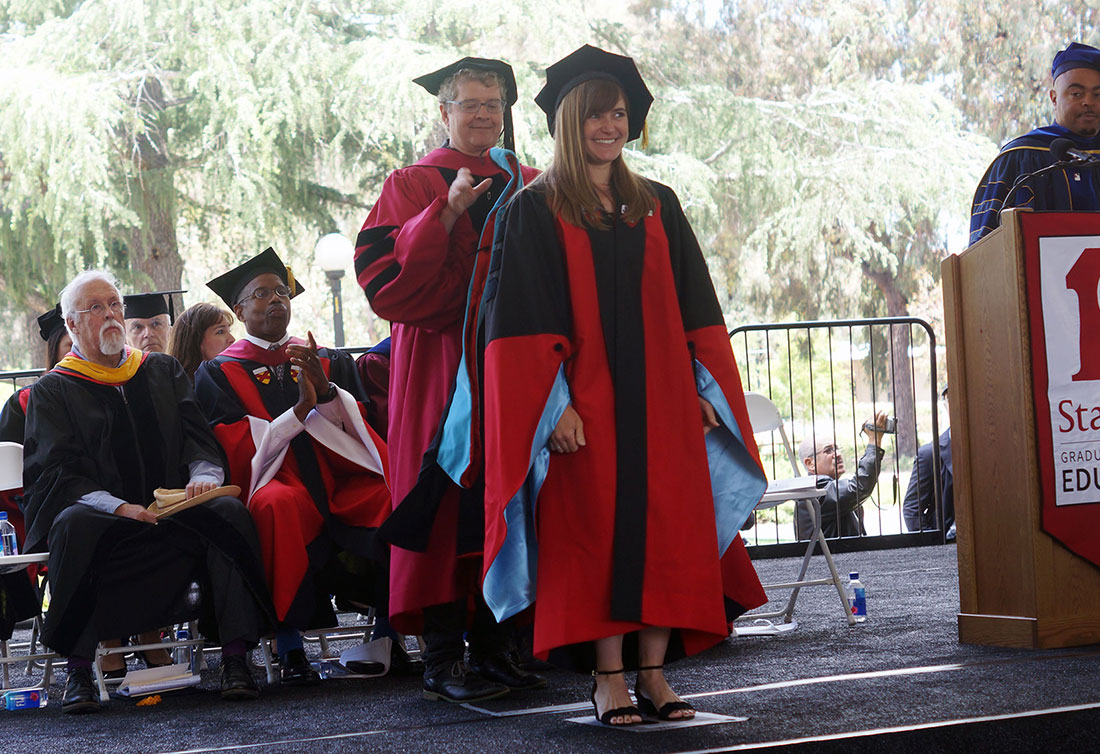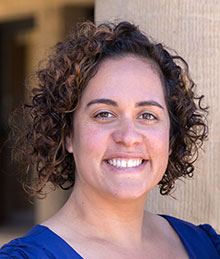News
- June 21, 2018
Congratulations to our new PhDs: Nina Cunha, Erin Fahle, Jenna Finch, Oded Gurantz, June Park John, Jing Liu, Joseph Townsend, Ericka Weathers, and Rosalía Zárate.

- June 18, 2018
“We set out saying that some districts are going to have more stereotypical gender achievement gaps—larger math gaps favoring boys, larger reading gaps favoring girls—and others that are maybe less stereotypical,” said Erin Fahle, who co-authored the study and earns her Ph.D. in education policy from Stanford this month. “Instead what we found was that districts tend to advantage boys or advantage girls.”
- June 13, 2018
“It could be about some set of expectations, it could be messages kids get early on or it could be how they’re treated in school,” said Sean Reardon, professor of poverty and inequality in education at Stanford, who conducted the study with Erin Fahle, a doctoral candidate in education policy there, and colleagues. “Something operates to help boys more than girls in some places and help girls more than boys in other places.”
- June 13, 2018
A review of test scores from 10,000 school district finds that gender gaps in math and English vary with community wealth and racial diversity.
When Stanford Professor Sean Reardon and his research team set out to take an unprecedented look at how elementary school girls and boys compare in academic achievement, they expected to find similar stereotype-driven patterns across all 10,000 U.S. school districts: boys consistently outperforming girls in math and girls steadily surpassing boys in reading and writing by a wide margin.
- June 06, 2018

- May 17, 2018
- May 16, 2018
Congratulations to @StanfordCEPA alumna @EmilyKPenner, recipient of a 2018 NAEd/Spencer Postdoctoral Fellowship Program @NAEduc https://t.co/YlVzkgONSJ— CEPA (@StanfordCEPA) May 15, 2018
- May 15, 2018
 Congratulations to Sade Bonilla for receiving 2018 National Academy of Education/Spencer Dissertation Fellowship.
Congratulations to Sade Bonilla for receiving 2018 National Academy of Education/Spencer Dissertation Fellowship.Sade Bonilla is a doctoral candidate studying the economics of education at Stanford University. She is an Institute of Education Sciences (IES) pre-doctoral fellow and recipient of the Association for Public Policy Analysis and Management (APPAM) Equity Inclusion fellowship.
- May 10, 2018
Students start college with a lot of uncertainty about how hard their coursework is going to be. So when they see those grade distributions, which often show that a high percentage of students get As, they may invest a little less effort in their coursework. Mitchell Stevens - Associate professor, Stanford Graduate School of Education
- April 18, 2018
B.C. public schools have one of the lowest ratios of male teachers in North America — and the trend is becoming more extreme.
As evidence mounts that boys suffer when there are few positive male role models in society and schools, only one of every 10 people entering B.C.’s teaching profession is a man.
The downward trend continues despite noted studies by a Stanford University education professor, Thomas Dee, and others that suggest boys generally do better in classes that are taught by men, while girls are more likely to thrive in classes taught by women.
- April 17, 2018
Chicago Public Schools, one of the largest school systems in the country, is reporting academic improvement in spite of past troubles. Now city leaders are looking to new CEO Janice Jackson to keep things moving forward.
Sean Reardon: "The growth rate from third to eighth grade in Chicago is the fastest among the 100 large districts in the United States. It is number one."
- April 11, 2018, Futurity
“The evidence that how male and female students are tested changes the perception of their relative ability in both math and ELA suggests that we must be concerned with questions of test fairness and validity,” says Sean Reardon, professor of poverty and inequality in education at Stanford Graduate School of Education and a senior fellow at Stanford Institute for Economic Policy Research.
- March 28, 2018
Measured achievement gaps between male and female students on state accountability tests are larger (more male-favoring) on tests with more multiple-choice questions and fewer constructed-response (i.e., open-ended) questions. Gaps are more female-favoring on tests with fewer multiple-choice questions and more constructed-response questions. Differences in the question format among states’ tests explain approximately 25 percent of the variation in achievement gaps across states and districts.
- March 22, 2018
When economist Eric Hanushek, at Stanford University's Hoover Institution, reviewed some 400 studies in 1989, he found "no strong or consistent relationship" between bigger school budgets and greater student success. The focus on how much different school districts spend, in school finance litigation and legislative deliberation, he added, "appears misguided." In 2015, the Texas assistant solicitor general made the point more colorfully, arguing against more school funding in court: "Money isn't pixie dust."
- March 21, 2018
The fictional students were randomly assigned names that connoted a specific race and gender.
“Simply attaching a name that connotes a specific race and gender to a discussion forum post changes the likelihood that an instructor will respond to that post,” the study said.
Dee said he was surprised by the magnitude of the effect of the instructor’s biases.
- March 13, 2018, NBC News
That’s a really dramatic finding because we think the discussion forums are important settings where student engagement and learning motivation gets supported and catalyzed,” Thomas Dee, co-author of the report and director of the Center for Education Policy Analysis at Stanford University, said. “If there's this type of bias in who's getting the engagement with the instructor, that, in a way, just reinforces patterns of inequity that many of us care about.